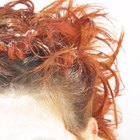Wigs and hairpieces have made a comeback in recent years. While most people prefer a human hair wig over a synthetic one, the cost of human hair is often prohibitive. That presents a major problem, however, for women who like to change their hair color regularly. While human hair is relatively easy to dye, synthetic hair is not. Below are some tips for coloring both human and synthetic hairpieces.
Coloring a Human Hair Wig
Choose the color of dye to be used on the wig. Pick a color that matches your hair exactly or go one shade lighter if the intent is to blend the wig with natural hair. If, however, the wig will stand on its own, choose any hair color desired.
Gather all of the supplies required before beginning. You don’t want to have to stop midstream in order to gather forgotten items.
Pin the wig onto the wig form using wig pins. Make certain it is secure and will not pull free while you add color.
Place an old towel that can be tossed underneath the wig form. This will help keep the dye off of the countertop or any other surface.
Apply hair color to the wig using the same process used for natural hair. Follow the instructions given on the hair color product instructions. Comb the dye through the wig using a wide tooth comb or a hair-pick. Pull the dye all the way through to the ends of the hair strands.
Check the dye color every 15 minutes until the color desired is achieved. Do not overprocess the wig or the hair may become permanently damaged.
Remove the wig from the wig form. Wash and rinse in cold water until the water runs completely clear.
Place the wig back onto the form for drying purposes. Using a wide-tooth comb or hair-pick to immediately work out any tangled strands.
Comb and style the wig as desired. Use hairspray sparingly during the styling process.
Coloring Synthetic Hair
Decide on the dye method. Spray or pen-dispensed hair paint will work on some synthetics but not all of them. On the other hand, acrylic paint works pretty well across the board.
Gather all of the supplies together and decide whether to do the dye job inside in a well ventilated area or outside.
Place the wig onto the wig form and pin securely in place. Then put the form onto a covered surface or a surface that can’t be permanently damaged by paint.
In a disposable container, mix equal parts of water and acrylic dye. Keep mixing until everything is thoroughly blended together.
Perform a strand test on the underneath side of the wig to make certain the chosen dye will work as desired. Check every 30 minutes until the desired color is achieved. If, after two hours, the desired color is not achieved then rethink the type of dye to use on the wig and try another of the above options.
Using a small paintbrush, work the mixture into the wig. Paint one section at a time and pin off with plastic or rubber clips before proceeding to the next section.
Let the paint mixture stand on the hair. Use the strand test timing to determine how long the mixture should remain on the wig
Remove the wig from the form and rinse in cold water until the water runs clear. Do not shampoo or condition.
Put the wig back on the form. Using a wide-tooth comb or a hair-pick, work any tangles out of the wig. Let the wig dry. This may take as long as 24 to 36 hours.
Related Articles

How to Dye a Human Hair Wig

How to Put Highlights on a Synthetic Wig

How to Remove Hairspray From Wigs

How to Color a Synthetic Wig Without Dye

How to Dye Your Hair Dark With Blond ...

How to Dye a Wig Pink with Kool Aid

How to Comb Out a Play Wig

How to Remove Color From a Human Hair ...

Best Way to Grow Color Out of Hair

How to Use Herbatint

How to Sew in Dreads

How to Write a Biography or ...

How to Dye Loc Extensions

How to Dye Sideburns

How to Re-Curl a Synthetic Wig

How to Dye Your Hairline

How to Mix Different Hair Dye Colors

How to Correct Uneven Blond Bleaching

Removing Hair Extensions With Acetone

How to Change Hair Color From Red to ...
Writer Bio
A business and education specialist for 30 years, Chantel Alise also owned a management and marketing training company. She has written newsletters and training manuals as well as business articles for Enid News and Eagle's Business Journal. She is principle writer for Beauty Biz. Alsie attended Thomas Nelson Community College (Virginia) and Phillips University (Oklahoma).